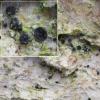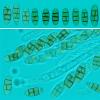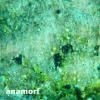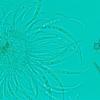
10-09-2025 23:53
 Marcel Heyligen
Marcel Heyligen
Found on Robinia pseudoacasia together with Diapor

11-09-2025 16:57
Our revision of Marthamycetales (Leotiomycetes) is

10-09-2025 17:18
 Blasco Rafael
Blasco Rafael
Hola, encontre este estiercol de vaca estos apotec

02-09-2025 11:34
Thomas Læssøehttps://svampe.databasen.org/observations/10527903

03-09-2025 21:59
Philippe PELLICIERLa Léchère, Col de la Madeleine, alt 1970m, au s

07-09-2025 11:34
 Zuzana Sochorová (Egertová)
Zuzana Sochorová (Egertová)
Hello,I have identified this fungus as Hymenoscyph
Strickeria kochii?
Marcel Heyligen,
10-09-2025 23:53

Found on Robinia pseudoacasia together with Diaporthe oncostoma and piycnidia with asexual spores.
Found in two completely different locations, two weeks apart.
On bark of a living trunk approximately 10 cm in diameter.
Ascomata less than 300 µm in diameter, spherical and collapsing in dry conditions, warty, with the piridium hard and difficult to obtain good microscopic results. Asci 100-126 x 11-13 µm, 8 spores, single-row, often not all evenly developed. Spores 13.80-20.57 x 5.67-7.86 µm, with frequently aberrant spores with 7-8 septa and longer than 30 µm.
Asexual ascomata are very small, 100 to 120 µm, warty. Conidia measured were crescent-shaped, with terminal cells up to 60 µm long and 4 septa. Could this be the anamorph of Strickeria kochii?
I only have the article from Persoonia Vol. 37, 2016: 82-105 (pp. 99-100, fig. 11).
Can anyone confirm this or provide more information?
Bernard Declercq,
12-09-2025 16:23

Re : Strickeria kochii?
Hi Marcel,
Indeed, this collection seems to fit the description in Jaklitsch et al. (2016). Nice photos!
Bernard
Indeed, this collection seems to fit the description in Jaklitsch et al. (2016). Nice photos!
Bernard
Marcel Heyligen,
12-09-2025 18:50

Re : Strickeria kochii?
Bedankt Bernard
Ik bezorg jou de gegevens en de foto's.
Met vriendelijke groetMarcel
Ik bezorg jou de gegevens en de foto's.
Met vriendelijke groetMarcel







